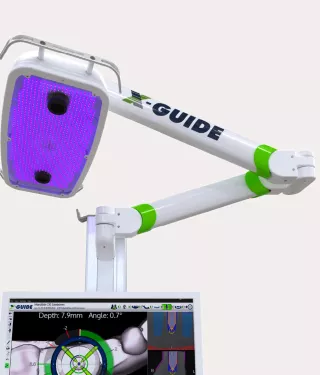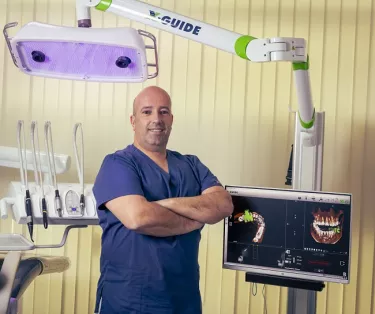
“Thanks to X-Mark™, I now use X-Guide® for every implant case”
The owner and operator of a private practice in Alicante, Spain, Dr. Didier Delmas is a self-described early adopter of new and emerging dental technologies. In this interview, he explains how he has integrated the X-Guide navigation system into his surgical workflows, and how its 3D visualization helps improve patient acceptance.
Dr. Delmas, could you please just tell us a bit about your professional background?
I currently own a small private practice in Alicante, though we are currently in the process of building a larger office. My main activities there generally involve dental surgery as well as aesthetic dentistry, and I’m very keen on adopting new technologies when they are released – for example, I started to conduct guided surgery more than ten years ago, though I quickly integrated navigated implant surgery when that became a possibility.
When did you first hear about X-Guide, and what were your initial thoughts?
For what kind of cases do you tend to use X-Guide?
I now use X-Guide for all my implant cases. At the beginning, we used it for partially edentulous cases but not for those that were fully edentulous because we didn’t have CBCT imaging capabilities in this clinic. But now, I can do anything from a single-implant case through to fully edentulous reconstructions.
This was after you introduced the X-Mark virtual registration tool into your workflows, correct?
Yes, thanks to X-Mark, I now use X-Guide for every implant case, because it allows me to do a virtual registration of the patient’s anatomy by marking three points on their 3D scan, which are then marked on the actual patient during surgery. By doing this, it fuses together the real and virtual anatomy of the patient by matching these points and so the accuracy of my implant surgery benefits greatly.
Was there a steep learning curve for using X-Mark?
No, not at all. After two or three cases, it became something that I did automatically, and I think that this will be the case for dentists who already have experience conducting navigated surgeries with X-Guide.
What do your patients think about X-Guide?
Some of my patients have entered the clinic and commented on this system, without even knowing if or what it has to do with their treatment. I often find that they are impressed and reassured that we invest in this kind of equipment.
It’s another part of how digital dentistry helps us give the patient a better treatment experience at every step. As well as offering the convenience of same-day surgery with X-Guide, I also show them a clear visualization of the diagnosis and treatment planning with the DTX™ Studio suite; I hand over the tablet to them and they can explore the images for themselves. It is an additional way of giving them confidence in us – helping minimize the uncertainties and fears that patients feel.
Do you know if other local dental practices have started using X-Guide?
Absolutely. I have had a lot of other dentists come to my clinic to witness it in action, and they’ve all been so impressed at how smooth and fast it can enable surgery to be. I know that many have since made the investment in this technology.
It is my opinion that, to be the best dental surgeon you can be, you need to know how to do it freehand first. But then you can have a whole better treatment experience with the right technology. We’ve even found it to be much more comfortable for the dentist, since they are more ergonomically positioned and looking at a screen, rather than leaning directly over a patient’s mouth which, in the long term, can be quite bad for your back. Ultimately, there are benefits for both patients and the practice.
